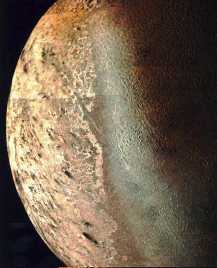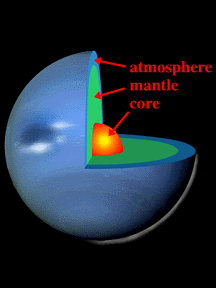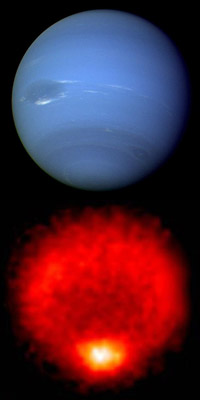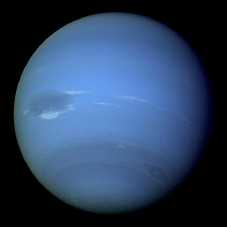This is an image of Neptune and its famous
Great Dark Spot
Click on image for full size
NASA
Discover Neptune
Neptune was discovered in 1846. But it wasn't discovered using a telescope. Scientists used math instead! They watched Uranus and saw that its orbit was doing weird things. They knew another planet had to be changing it. They were right!
Neptune's largest moon, Triton, was discovered at the same time as Neptune. Another moon called Nereid was found in 1949. Neptune's other six moons were found by Voyager II in 1989. Voyager II took many pictures of Neptune and its moons. Almost everything we know about this planet came from the Voyager II mission.
Neptune is usually the eighth planet out from the Sun. But sometimes Pluto actually crosses in front of it! Neptune was named after the ancient god of the seas.
You might also be interested in:

What types of instructional experiences help K-8 students learn science with understanding? What do science educators teachers, teacher leaders, science specialists, professional development staff, curriculum designers, school administrators need to know to create and support such experiences?
...more
Triton was discovered by W. Lassell in 1846. Of the 8 moons, it is the 2nd farthest from Neptune. Triton may be one of the largest of the icy moons with a diameter that is about half the distance across
...more
Neptune was the name that ancient Romans gave to the Greek god of the sea and earthquakes, Poseidon. Neptune was depicted as a bearded man with long hair, holding a trident and accompanied by dolphins
...more
Neptune has // Call the moon count function defined in the document head print_moon_count('neptune'); moons. It also has rings, but its rings are different from Saturn's. Neptune's largest moon is named
...more
The Giant planets do not have the same kind of layers inside that the Earth-like planets do. The history of the giant planets was so different that they formed with much more gas and ice on the inside.
...more
The South Pole of the planet Neptune is a bit strange. Triton, Neptune's largest moon, also has interesting poles. Neptune is tilted on its axis by about 28°. That isn't so strange... Earth is tilted,
...more
The atmosphere of Neptune is a lot like that of Uranus, and unlike that of Saturn and Jupiter. On Jupiter and Saturn, the atmosphere is mostly made of the simple molecules hydrogen and helium. The atmosphere
...more
There are four ideas for where the atmosphere comes from: 1. that the planet-elements which made the planets made the atmosphere too, 2. that the atmosphere was drawn to the planet from the cloud out of
...more














